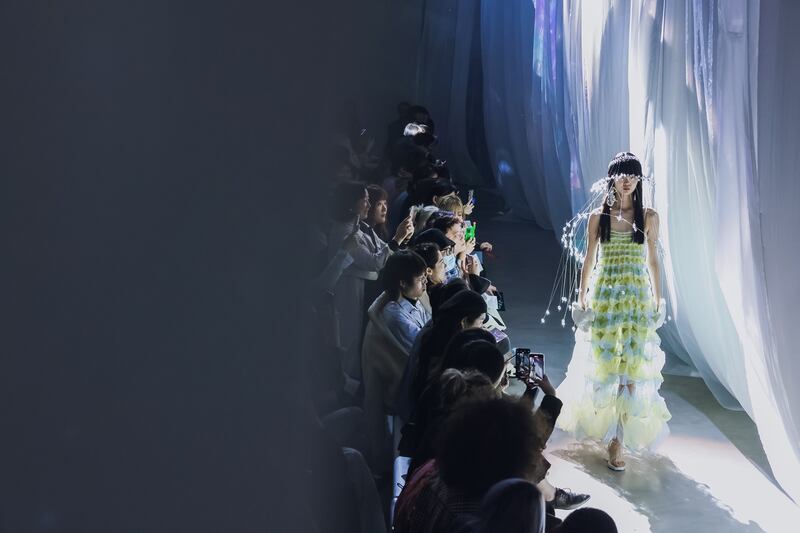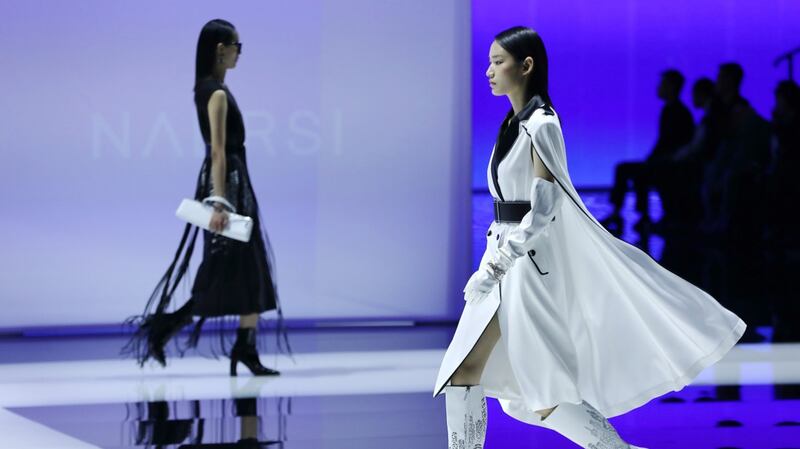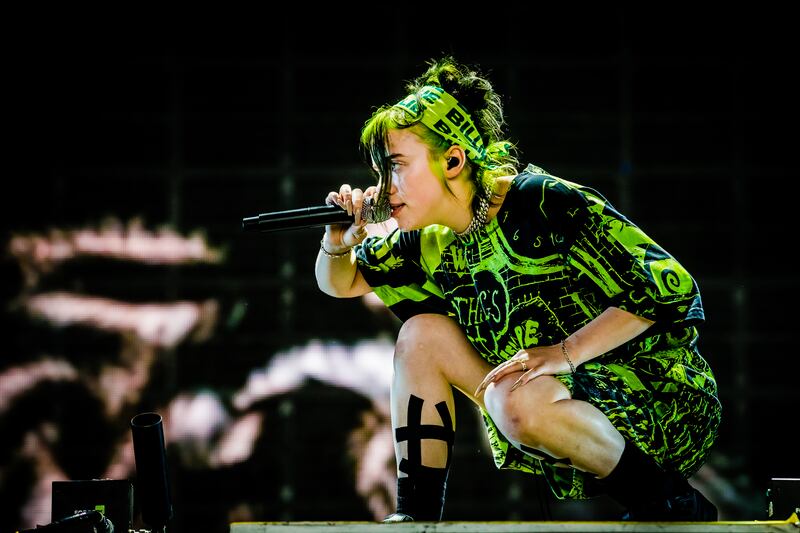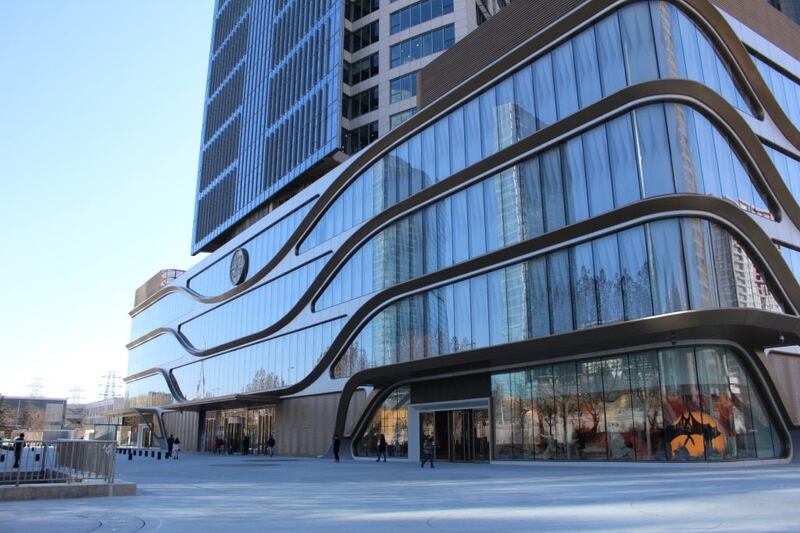
The Business of Fashion
Agenda-setting intelligence, analysis and advice for the global fashion community.

Agenda-setting intelligence, analysis and advice for the global fashion community.

A year ago, China was only beginning to emerge from the worst of its battle with Covid-19. But despite the damage done to the country’s retail sector, a tough first and second quarter didn’t stop Meimei Ding, CEO of Shanghai-based showroom and buying agency, DFO, from having a record-breaking year.
“We employed strategies from running online sales campaigns to breaking the original fashion cycle and showing collections in our physical showroom all year round,” said Ding, who is currently in the thick of preparations for Shanghai Fashion Week, which returned to staging physical shows last autumn. Showcases for the Autumn/Winter 2021 season kicked off today.
Alongside more than 100 runway shows, this season’s schedule is packed full of B2B activations from symposiums to exhibitions, not to mention a growing guild of showrooms and trade shows.
The fashion week’s official trade show Mode Shanghai (entering its 13th season with a catalogue of over 300 brands), Ontimeshow, Tube Showroom and Not Showroom will be among the players driving orders in what many expect will be an unprecedented sales season. These will take place just after fashion trade show Chic, which ran from March 17 to 19, and saw more than 88,000 visitors.
ADVERTISEMENT
Some changes — from bigger buyer budgets and shuffled timelines to new consumer touchpoints — are here to stay.
Wholesale may be struggling elsewhere but in China’s niche designer segment it seems to be thriving. “Last April, all of our brands got good sales increases [despite the lockdown],” said Zemira Xu, founder and CEO of Dia Communications and Tube Showroom. “Last October, some of the brands saw more than 100 percent to 400 percent [boosts] in wholesale.”
Order volumes aren’t the only thing changing for brands, showrooms, trade shows and agencies, all of which are working to adapt to a post-pandemic reality. Some changes — from bigger buyer budgets and shuffled timelines to new consumer touchpoints — are here to stay.
A Boon for Brands
Chinese buyers’ unused travel budgets, which they would have spent on venturing to Paris and Milan in search of fresh talent and to close orders with European showrooms, have been a windfall for local brands, said designer Susan Fang.
Fang will be hosting her appointments from April 5 to 12 following her show on March 28 and has seen her mainland sales grow three to four times last season, compared to the previous one. Demand for homegrown talent has soared, thanks in part to well-off younger shoppers who remain in China post-pandemic and have been spending enthusiastically, she noted.

But some global brands, too, have benefitted from an overall increase in demand, said Julio Ng, Shanghai-based director at creative consultancy Seiya Nakamura 2.24. “There are more and more stores committed to buying international brands, because of the sales growth post-Covid... everyone has more budget to work with.”
With international travel still on hold, hard-to-find young designers that shoppers would have purchased at boutiques like London’s Dover Street Market or Paris’ Broken Arm are particularly popular; take Ng’s clients Kwaidan Editions and Namacheko, which have both seen sales rise significantly since the pandemic. But not all brands are reaping the rewards. Ding noted that while brands with strong traction have kept up the momentum, newcomers are finding it harder to make headway. “We feel that the market is buying more safely,” she said.
Though the travel sector’s leaden recovery may suggest otherwise, Chinese buyers aren’t going to be homebound for good. But that doesn’t mean there will be a dramatic reversal of current dynamics once flights resume either. The pandemic has forged stronger relationships between buyers and local brands which Fang reckons will persist; local designers in particular have become more responsive to the market’s trends and price sensitivity, she said.
ADVERTISEMENT
“Stores are not going to drop [brands] but they’ll think more precisely about what to add,” said Ng. “The connection has been established, the clientele is there.”
Stretching the Schedule
The surge in domestic demand is allowing Chinese designers to find timelines that work for them. “People are less strict about the fashion schedule and ordering times,” said Fang, who held both last season and this season’s shows earlier than the official Shanghai Fashion Week schedule. Other brands, from sportswear giant Li Ning to Short Sentence, have done the same.
For some, this is a power shift. “If you’re selling well, the store knows it and they have to make time to see you,” said Ng. He, too, strayed beyond the schedule and completed showroom orders well before shows kicked off, a decision that allows his team to deliver earlier and thereby secure their budgets earlier. “If we followed the schedule we’d be fighting with 100 clients for 200 brands,” he said. “If you show earlier, buyers will spend their budgets on you.”
The addition of digital appointments has further upended Ng’s schedule, but his current strategy is to go with the flow. “Some brands start early, some brands start late and brands stretch their sales campaigns. It’s difficult, but it’s important to adapt.”
Many of us in the industry feel that the main seasons are over-crowded.
To be sure, this shift won’t be welcomed by all brands and buyers; the lack of structure and consistency can be “unhealthy,” notes Ng. The role of Shanghai Fashion Week in providing that structure remains valuable, but it’s clear that the solutions brands, buyers and agencies have found, from focusing on social media to direct-to-consumer initiatives, aren’t provisional.
“Certain rules and industry traditions that have been broken will stay broken,” said Ding, who sees the change as a positive one. “Many of us in the industry feel that the main seasons are over-crowded, so more options spread throughout the year are good for both designers and retailers.”
New Digital Touchpoints
ADVERTISEMENT
While e-meeting technology like Zoom and Google Hangouts and virtual showroom platforms including Joor and Le New Black have become de rigueur across the industry, physical formats are set to make a comeback. At the same time, diligent designers — homegrown or otherwise — have grown adept at showcasing their work in other ways (think fabric swatches, better photography and videography, or livestreams) and no longer see costly runway shows as the only way to showcase their vision.
Integrating new technologies with much-anticipated physical appointments will be key. “Not all the buyers will be able to go to Paris, or attend the shows,” said Ng, adding that a global 5G rollout could be a gamechanger.
Meanwhile, China’s answer to micro-influencers — known locally as key opinion customers (KOCs) — are proving increasingly important at the B2B level.
“Those are the people that brands’ target customers are following,” said Ng, who sees KOCs as a new way to decipher trends and consumer sentiment. His clients like Song for the Mute and Namacheko have drawn communities of loyal customers in China, which has resulted in the emergence of multiple group chats on messaging and multi-purpose app WeChat. Song for the Mute designer Melvin Tanayawas was even invited to join in on the discussions.
The sheer number of brands in the market means retailers will increasingly rely on platforms to do their sourcing.
“People talk about the collections, discuss where they’re stocked and sell archive pieces,” Ng said.
In addition to serving as digital meeting points for a brand’s community, these touchpoints provide buyers and designers with a valuable window into what influential Chinese shoppers are looking for and have helped Ng boost sales. It gets even more interesting where one brand’s following intersects and aligns with another label’s to paint a richer picture of a target fashion audience.
The Years Ahead
With Chinese spending expected to further localise following an initial travel spending boom once flights return, the incentive for local multi-brand stores to amp up their offerings is clear. “I think the market will continue to grow, with more boutiques purchasing wholesale,” said DFO’s Ding.
Ding expects a continuation of current market dynamics, where the field is dominated by key players; the sheer number of brands in the market means retailers will increasingly rely on platforms to do their sourcing.
But as brands find new ways to rethink their business models — be it through direct-to-consumer channels or setting their own order timelines — Ding reckons that stronger labels will begin bringing wholesale in-house, by skipping trade shows and showrooms. The likes of OTB Group and Cecilie Bahnsen are already doing this through their own showroom platforms.
This makes it all the more important for global brands to keep up with domestic shifts and make themselves heard. “They need strong local partners to help facilitate this, to localise the way they do business in China in order to achieve decent growth,” said Ding.
时尚与美容
FASHION & BEAUTY

China Fashion Week Bows in Beijing
Beijing’s China Fashion Week featured 64 brands showcasing their Autumn/Winter 2021 collections. The calendar included a total of more than 300 events such as fashion competitions, trade shows and industry forums. Traditional Chinese heritage and craftsmanship were highlighted by labels such as Chuyan, Heaven Gaia and Grace Chen, and designers from 16 countries and regions including Malaysia, Mongolia, India, Japan, Australia and Canada took part. In recent years, the protection of intellectual property has been one of China Fashion Week’s focal points and the China Fashion Industry Intellectual Property Conference was also be held during the event. (BoF)
Shanghai Fashion Week Kicks Off
Shanghai’s fashion community is back in the tents at Xintiandi’s Taiping Lake Park to see catwalk shows from brands including Comme Moi, Leaf Xia, Yes by Yesir and Dawei running on the official schedule from today until April 13. The Labelhood platform for independent designer showcases runs concurrently at the Tank Museum in Shanghai’s arts and cultural West Bund hub and features designers including Angel Chen, Shushu/Tong, Private Policy and Oude Waag. Joining Labelhood on the West Bund will be Dior, which is showing its women’s pre-fall collection at the Long Museum there on the evening of April 12. Ermanno Scervino and Jason Wu are among other international names planning shows to coincide with Shanghai Fashion Week. (BoF)
China May Ban CBD Beauty
Chinese authorities are soliciting opinions regarding a prohibition on cannabis-related ingredients for use in beauty products, according to a notice published on the National Institute for Food and Drug Control (NIFDC) website. Cannabis sativa kernel fruit, cannabis sativa seed oil, cannabis sativa leaf and cannabidiol (CBD) are all listed as components that would be banned under a proposed new legislation, the notice said, with the deadline for feedback on the proposal set for April 9. The new legislation would overturn a previous 2015 ordinance that allowed the use of these ingredients in beauty products in the China market. CBD beauty is in its nascent stages in China, though local C-Beauty players such as Simpcare and One Leaf have been leveraging the clean and natural message of CBD beauty to raise money and build hype on local social media platforms, including Xiaohongshu and Bilibili. (BoF)
Yi Yangqianxi and Li Yuchun Pick Up New Beauty Ambassador Roles
Armani Beauty has announced Chinese actor and singer Yi Yangqianxi, also known by the English name Jackson Yee, is its new global makeup and skin care ambassador. Yi, who rocketed to fame as a member of the TFBoys boyband has been a China ambassador for Giorgio Armani makeup since January 2020, and an Emporio Armani global ambassador since August 2020. Meanwhile, Li Yuchun, also known by the English name Chris Lee, has been unveiled on social media as YSL Beauty’s new ambassador, the first spokesperson for the brand to come from China. Li’s continued star power was in evidence as the announcement of her affiliation with YSL Beauty hit Weibo, with 1.1 million views for the campaign hashtag within four hours. (BoF / BoF)
科技与创新
TECH & INNOVATION

Billie Eilish Is the Latest Celebrity to Open a Tmall Store
Billie Eilish has opened a cross-border e-commerce store on the Tmall Global platform, selling a range of her “blohsh” branded apparel and accessories. The store sells hoodies, hats and necklaces priced between 130 and 500 yuan (approximately $20 to $75). Eilish is just the latest international celebrity to plug into China’s booming e-commerce ecosystem. During last year’s Singes’ Day festival, Tmall Global partnered with Bravado, Universal Music Group’s merchandising and brand management arm, to launch merchandise tied to Taylor Swift’s latest album “Folklore” in China, two weeks ahead of other parts of the world. Justin Bieber’s Drew House brand also has an e-commerce presence in China, launching its own store via WeChat mini-programme in March 2020. (BoF)
Douyin Launches Flagship Stores for Brands
The Chinese version of short video app TikTok has launched flagship storefronts for brand accounts on its platform, to help it move further into the e-commerce space. The stores promote new products, popular items, livestreams and the distribution of vouchers, which can be used both online or offline. According to Douyin, more than 220 brands, including Winona, Peacebird, and Perfect Diary have already introduced flagship stores with international brands, many of which are active on the platform, likely to follow suit. Douyin-owner, ByteDance, set up its e-commerce department in June 2020 and said its gross merchandise volume (GMV) has so far exceeded 500 billion yuan ($77.5 billion), including transactions on its Douyin Xiaodian marketplace and deals directed to third-party e-commerce platforms such as JD.com and Taobao. (BoF)
消费与零售
CONSUMER & RETAIL

Chinese Department Stores Focus on Digital and Direct Sales
The “China Department Stores Report 2020-2021″ from the China Commerce Association for General Merchandise (CCAGM) and Fung Business Intelligence Centre (FBIC) showed that, although some properties, particularly luxury properties in top tier cities, outperform the sector, most of the surveyed department stores “lack product appeal and competitiveness, offering widely homogeneous products at unattractive prices.” The traditional concession model still dominates the operation of China’s department stores, although direct sales have been identified as an important strategic direction for the sector. From a digitalisation perspective, 89 percent of surveyed respondents have established an e-commerce business and among them, around 94.4 percent are selling via WeChat. (BoF)
Japan’s Lalaport Mall Starts Asian Expansion From Shanghai
Japanese real estate giant Mitsui Fudosan will open the first Lalaport shopping mall outside of Japan in Shanghai on April 28. It marks the beginning of an international expansion for Lalaport, which has 18 locations around Japan, that will also encompass two properties in Taiwan and one in Kuala Lumpur in the near future. The Lalaport Shanghai Jinqiao, will be located in a middle class eastern suburb of Pudong District, and will have about 220 stores, including 13 Japanese restaurants, in a total shopping area of some 60,000 square metres. Some of the stores will feature Japanese lifestyle brands that have, until now, not had a physical presence in the China market. Another draw, Mitsui Fudosan hopes, will be an 18-metre-tall statue of anime robot soldier Gundam outside its Shanghai outlet, a likely favourite for selfies with shoppers once the mall opens later this month. (BoF)
Chinese Menswear Giant Septwolves Sees 2020 Profits Decline 40%
According to Septwolves annual report, the company’s net profit attributable to shareholders in 2020 amounted to almost 209 million yuan ($31.9 million), a year-on-year decrease of 40 percent. The high street menswear brand, also saw operating income decrease by 8 percent on the year. The brand, which is heavily reliant on its extensive physical retail network across China, has not been able to capitalise on the country’s shift to online shopping in the way some of its competitors have, exacerbating its problems in 2020. Though the country emerged from the worst of its Covid-19 outbreak in the second quarter, Chinese shoppers remained wary of crowded shopping centres, and more likely to shop for mass market fashion items online. (BoF)
政治、经济、社会
POLITICS, ECONOMY, SOCIETY

H&M Pledges to Rebuild Trust in China
In a statement alongside quarterly results announced last week, H&M said that its commitment to China remained strong and it was dedicated to regaining the trust and confidence of customers, colleagues and business partners there. “By working together with stakeholders and partners, we believe we can take steps in our joint efforts to develop the fashion industry, as well as serve our customers and act in a respectful way,” it said. The statement made no specific mention of Xinjiang. China is H&M’s fourth-biggest sales market and its biggest sourcing market. (Reuters)
Chinese Travellers Come Out in Force for Qing Ming Festival
China’s three-day Qing Ming Festival weekend, which came to an end Monday, saw domestic travel rebound to pre-pandemic levels. According to the data of the Ministry of Culture and Tourism, 102 million domestic trips were made during the festival, an increase of 144.6 percent year-on-year and a recovery to 94.5 percent of the same period in 2019. Data provided by Chinese tourism service website Qunar.com also showed that during this year’s Qingming Festival holidays, ticket bookings on the website were 1.4 times more than 2019, while hotel bookings were 1.5 times higher compared with 2019. (Global Times)
Chinese Factories Raising Prices on Apparel and Footwear
The rising costs of raw materials, coupled with ongoing supply-chain strains mean Chinese manufacturers are raising the prices of export goods, including apparel and footwear. Cotton prices alone have jumped to around $2,600 a tonne in early March, compared with around $1,990 a tonne in mid-February. The six-day blockage of the Suez Canal worsened the impact of supply-chains already constrained following the pandemic, with long lulls in orders, followed by a sharp increase in demand from Western countries exiting lockdowns, causing a shortage of shipping containers and a back up of shipments at ports where goods manufactured in China and the rest of Asia would normally be unloaded. Prices for imports from China to the US rose 1.2 percent over the past year, the fastest increase since 2012, with most of the increase coming in the three months ending in February, according to data from the US Bureau of Labor Statistics. (The Wall Street Journal)
With consumers tightening their belts in China, the battle between global fast fashion brands and local high street giants has intensified.
Investors are bracing for a steep slowdown in luxury sales when luxury companies report their first quarter results, reflecting lacklustre Chinese demand.
The French beauty giant’s two latest deals are part of a wider M&A push by global players to capture a larger slice of the China market, targeting buzzy high-end brands that offer products with distinctive Chinese elements.
Post-Covid spend by US tourists in Europe has surged past 2019 levels. Chinese travellers, by contrast, have largely favoured domestic and regional destinations like Hong Kong, Singapore and Japan.